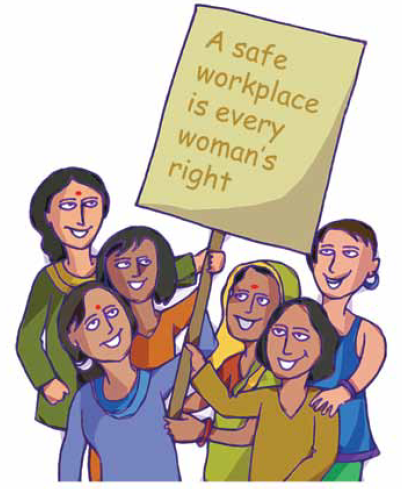Global norms and Good practices
Global norms and Good practices
Increasing awareness and compliance with international standards is a reminder that we must not lose sight of the goal. Over the years, the international community has developed benchmarks that provide guidance on what the laws around workplace sexual harassment should look like in practice.
Key benchmarks
The key benchmarks are listed below:
- Recognition that workplace sexual harassment is a form of human rights violation.
- Recognition that sexual harassment is a form of gender-specific violence.
- Equality, dignity and worth of a human person must be emphasized.
- Gender-based violence includes sexual harassment and impairs the enjoyment by women of several basic human rights and fundamental freedoms. Some of these rights include:
- The right to life, the right to liberty and security of the person.
- The right to equal protection under the law.
- The right to the highest standard attainable of physical and mental health.
- The right to just and favourable conditions of work.
- Eliminating violence against women and advancing women’s equality includes the right to be free from workplace sexual harassment.
- Legislation on violence against women should define violence to include sexual harassment. Such legislation should also recognize sexual harassment as a form of discrimination and a violation of women's rights with health and safety consequences.
- The International Labour Organization (ILO) has also drawn specific attention to domestic workers, who have a right to “enjoy effective protection against all forms of abuse, harassment and violence.”
In terms of practice, international law and policy frameworks have an important role to play in encouraging the adoption of an understanding of sexual harassment as a fundamental human right and equality issue, and not just a problem for labour/employment law to solve.
Simple steps for practice
Converting these concepts into practice involves constant monitoring and adapting to changing circumstances. As a start, six simple steps to keep in mind and practice in any workplace should involve the following:
- Make sure there is a policy that has been “effectively” communicated to all workers, irrespective of whether they are paid or volunteers.
- Display details of both informal and formal ways available to a worker to address/complain about workplace sexual harassment.
- Undertake orientation on workplace sexual harassment for all workers in respective organizations, establishments or institutions.
- A Complaints Committee which is trained in terms of skill and capacity is critical for building trust.
- Encourage senior persons/leaders/supervisors or any person who can influence employment related decisions, to become role models.
- Men and women should be included in building a culture which no longer tolerates workplace sexual harassment.

Legally, workplace sexual harassment can no longer be dismissed as some moral transgression. The Vishaka Guidelines raised that bar, when for the first time it recognized “each incident of sexual harassment” as a violation of the fundamental right to equality. That notion has found its way into the Act, which promotes the right of women as citizens to a workplace free of sexual harassment. Complaints Committees at all workplaces are now charged with the role to ensure that the right remains intact, through a fair, informed, user-friendly process of redress.
Prioritising prevention and establishing a redress mechanism, which comprises of 50 per cent women, a woman chair and an external third party expert, is India’s innovative model in responding to working women’s experience of sexual harassment. Assuming adequate changes follow, in both law and practice to meet global benchmarks, that model can evolve into an exemplary best practice. To get there, workplaces in India today, must rise to the requirement of promoting gender equality.
Source : Handbook on Sexual Harassment of Women at Workplace
Last Modified : 5/24/2024
This topic covers the information related to Sexua...
This topic provides information about the monitori...
This topic provides information about the Sexual H...
This topic covers the Information related to Rape
